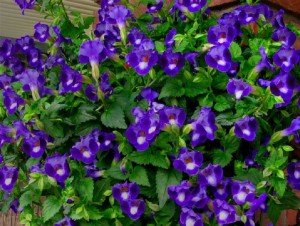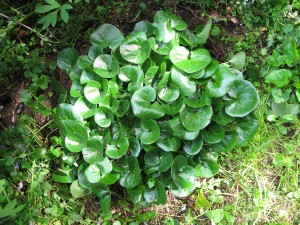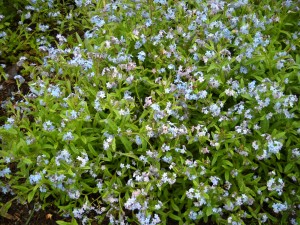Shade Annuals
Last fall a reader alerted me to the fungal disease that has devastated that wonderful shade annual, impatiens, throughout much of New England. The disease, called impatiens downy mildew, will be a problem again for most gardeners this year. Any garden that had the disease last year will have it again this year – even our coldest winters will not cleanse the soil of it. I wish I had known about it sooner, as prompt removal of affected plants may stop the spread of the disease. So if you did not have the disease last year, watch your plants carefully this year and bag and dispose of any diseased plants promptly.
Impatiens downy mildew symptoms are these: yellowing of leaves, then a limp appearance, as if it needs to be watered. Next comes a downy white fungal growth on the undersides of leaves. Then leaves and flowers drop, leaving just a stem with a few leaves on top – as if slugs had eaten the leaves. I have read that if you don’t plant impatiens in a site that has had the disease for a year or two, the soil may become free of disease. But I wouldn’t count on it.
There are two related plants that will thrive in shade or part shade and that are not susceptible to the mildew: New Guinea impatiens and SunPatiens, which is a trademarked hybrid. SunPatiens is advertised as good for part sun to sun – but not deep shade. But it is being marketed as a replacement of impatiens. I wonder if it will be able to bloom as vigorously as our old favorite in full shade. Both are generally sold in individual pots for around $5, quite an upgrade from a six-pack for $3.50 or so that I was accustomed to paying for impatiens in past years.
Another plant that is being touted as a replacement for impatiens is Torenia. I spoke to two landscapers who have used Torenia in past years and say that it is nice enough, but it will not satisfy impatiens-lovers. I’ve heard that it does not have as many blossoms per plant, generally, and is often available in just a few colors – shades of blue and purple, and in white. However, I have found it for sale in multi-packs in a few places and did find one nursery with 4-packs that listed rose, magenta, lemon drops and white as colors available.
I have used bedding lobelia as a nice shade annual, though in my experience it wants a little sun or filtered sun. I love the intense blue that it often displays, though it is available in other colors, too. I started seeds indoors back on April 17, a mix called ‘Cascade of Color’ that promised blue, blue with a white eye, lilac, red, ruby and white.
Right now my lobelia seedlings are only 2 inches tall but I assume they will take right off when I separate them and get them in the ground. The only problem with a mix like that is that one cannot determine what color any given seedling will be – unless you wait for them to bloom in the pot. And, when I read the seed packet (from Botanical Interests) just now, I see that this variety is advertised for full sun. I have plenty, so I’ll try some in shade, too.
So what else can we do to provide color in shade? Try some perennials. Granted, most only bloom for 1 to 3 weeks, but if you select plants with good foliage they can be a joy all summer. I love European wild ginger (Asarum europaeum) for its very glossy dark green leaves. It forms a nice expanding clump, even in dry shade with competition from tree roots. The blossoms are hidden beneath the foliage, but it doesn’t matter to me. This is a great shade plant. I plant them in clumps of three about 18 inches from center to center.
Then there is bigroot geranium (Geranium macrorhizum). Not to be confused with your mom’s red geraniums (which are technically not geraniums at all), this is a nice spreading plant that thrives in full shade and blooms with pink, magenta or white flowers in late May or early June. The leaves look good all summer, each plant a spreading mound 12 to 18 inches tall and 15 inches wide. I use it as a groundcover. I have read that it will do well in sun, too, and that it tolerates a wide range of soil and pH conditions. If it wanders too far? It pulls easily, and you can give the roots to someone who doesn’t have it.
I have never tried either the geranium or the ginger in a pot, but will this year and grow them on my north-facing, shady deck. I’ll give them a 50-50 mix of standard potting soil and compost, and I bet they look just fine.
It seems that every year there is a new bug or a new disease that threatens some plant in our garden. I guess we will have to keep on adapting and changing – just like the pests do. Good luck!
Henry Homeyer is the author of 4 gardening books and a children’s fantasy-adventure called Wobar and the Quest for the Magic Calumet. You may reach him at PO Box 364, Cornish Flat, NH 03746 or henry.homeyer@comcast.net.\
Spring Forth Into Spring
This is a busy time for all of us in the garden. Not only are weeds up, some of them are already blooming. I try real hard to keep weeds from spreading their seeds in my garden beds, so I am doing my best to pull them now before they bloom and make seeds. And there is so much else to do I’m not sure if I have time to write this column!
Apple and crabapple trees are blooming everywhere, which draws my eyes to them. I can’t help but notice that so many need a little late pruning. What I keep seeing are root sprouts coming up alongside the trunk of these lovely trees, which is a distraction. And it only takes 5 minutes with a pair of loppers or a hand saw to remove those shoots.
While you’re at it, you may wish to take off any little branches that are sprouting from the main trunk below the first scaffold branches (those larger branches that reach out and up, and that have all those blossoms on them). A nice clean trunk is much better than one cluttered with unwanted sprouts.
Then there is the vegetable garden. I know we will still have frost here in Cornish Flat, so all those tomatoes and peppers and squash that I have started by seed inside need to stay in their pots. What I can do now, however, is” harden off” those seedlings. Hardening off is the process of getting seedlings ready for life outdoors.
Each nice day I should (but don’t always) carry all 12 trays of seedlings outdoors so my plants can work on their tan. That’s right, seedlings are like us – they need to start with just a little sunshine and breeze each day. Two hours of morning sun is good for a start, then 4 hours, then 2 hours of afternoon sun, and so on, increasing exposure until their leaves won’t burn or dry out even if they’re in the sun all day. If you buy seedlings it’s good to give them time to get used to the outdoors, too. Greenhouses do shelter seedlings considerably.
Right now I have thousands of forget-me-nots (Myosotis sylvatica) blooming everywhere: in garden beds, in the lawn, in the vegetable garden – even on the banks of my little stream (they love water). If you don’t have this fabulous, exuberant flower, you should. I wish I could give every reader a clump, but I bet one of your neighbors will share some with you, as most everyone has it. I rarely see them for sale at nurseries, but a few of the better ones do. Many flower books say they are biennials, but I’m not sure that’s true. Biennials only bloom in their second year, and then die. I have so many, it’s hard to know if they are re-seeding or coming back from their roots. So they may be perennials.
While weeding a patch of daffodils recently, I decided to take advantage of the fact that I had thoroughly loosened the soil surface. I spread my favorite organic fertilizer, Pro-Gro over the soil surface and scratched it in with my favorite weeder, the CobraHead. I had notice that those daffies were not flowering as previous years and decided to give the soil some extra nutrition and get rid of the weeds that were competing with them. Next spring I should have better blossoms.
Some gardeners like to divide big clumps of daffodils, though I generally don’t get around to it. The problem is that by fall I don’t know where those big clumps that need dividing are. The solution? Make some markers now and stick them in the soil. That works for marking places that need more bulbs, too.
It’s past time to rake off that leaf mulch or straw if you covered your vegetable garden with mulch last fall. I just raked mulch off my beds and into the walkways last week. By exposing the soil to the sun I do 2 things: I let the soil warm up and dry out more quickly, and I encourage weed seeds to germinate. I want the weeds to germinate before I plant so that I can hoe them over or pull them out, killing them before I plant. I also have a flame weeder which will burn off dozens of small annual weeds with a single, quick pass. (Available at Johnny’s Seeds or Fedco Seeds). But it does use propane, so is not as eco-friendly as hoeing.
Traditional gardeners grow their carrots, corn and cauliflower in narrow rows on flat ground. I don’t. I have mounded up beds that are 3 feet wide and 6 to 8 inches higher than the walkways. Wide beds produce more planting space in a garden when compared to those with narrow rows because there are fewer walkways. The wide, higher beds allow roots to spread wider and deeper than in traditional beds, and dogs and kids tend to stay out of them.
But if you have a sunny, warm weekend, don’t spend all day pulling weeds or working. Take time to sit and enjoy your flowers – and the butterflies, kids and dogs that love the garden, too.
Henry’s Web site is www.Gardening-Guy.com. It now has a search engine for finding any past columns you might have missed.






